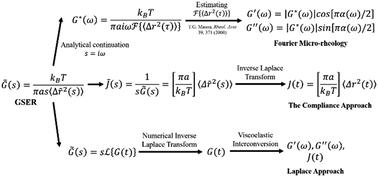当前位置:
X-MOL 学术
›
Soft Matter
›
论文详情
Our official English website, www.x-mol.net, welcomes your
feedback! (Note: you will need to create a separate account there.)
The Laplace approach in microrheology
Soft Matter ( IF 2.9 ) Pub Date : 2020-03-16 , DOI: 10.1039/c9sm02242b Qi Li 1, 2, 3, 4 , Xiaoguang Peng 1, 2, 3, 4 , Dongjie Chen 1, 2, 3, 4 , Gregory B. McKenna 1, 2, 3, 4
Soft Matter ( IF 2.9 ) Pub Date : 2020-03-16 , DOI: 10.1039/c9sm02242b Qi Li 1, 2, 3, 4 , Xiaoguang Peng 1, 2, 3, 4 , Dongjie Chen 1, 2, 3, 4 , Gregory B. McKenna 1, 2, 3, 4
Affiliation

|
When coupled with the generalized Stokes–Einstein (GSE) equation, it is often reported that micro-rheology probes the dynamic properties differently than do macroscopic rheological measurements, especially in relatively condensed systems. In the present work, we empirically examine the GSE in its widely used form: following an analytical continuation, the Fourier transformed particle mean-square displacement (MSD) is used to determine the dynamic moduli [G′(ω) and G′′(ω)] and we compare the results with those obtained by direct inverse Laplace transform calculation of the relevant viscoelastic functions (either relaxation modulus or creep compliance) from the MSD. The results show that the inverse Laplace approaches can differ from the Fourier approach and give better agreement with macroscopic rheological measurements when this is the case. Some instances of agreement between the Fourier approach and the direct Laplace transform approaches are also shown. It is recommended that micro-rheology MSD data be interpreted using one of the direct Laplace transform based approaches.
中文翻译:

微流变学中的拉普拉斯方法
当与广义的斯托克斯-爱因斯坦(GSE)方程耦合时,经常有报道说,微观流变学探测的动态特性与宏观流变学测量的不同,特别是在相对冷凝的系统中。在本工作中,我们以经验形式检查了GSE的广泛使用形式:在进行分析连续之后,使用傅立叶变换的粒子均方位移(MSD)来确定动态模量[ G '(ω)和G ''(ω)],然后将结果与通过MSD的相关粘弹性函数(松弛模量或蠕变柔量)的直接拉普拉斯逆变换计算获得的结果进行比较。结果表明,在这种情况下,逆拉普拉斯方法可能与傅立叶方法有所不同,并且与宏观流变学测量结果具有更好的一致性。还显示了傅立叶方法和直接拉普拉斯变换方法之间达成协议的一些实例。建议使用基于直接拉普拉斯变换的直接方法之一来解释微流变MSD数据。
更新日期:2020-04-24
中文翻译:

微流变学中的拉普拉斯方法
当与广义的斯托克斯-爱因斯坦(GSE)方程耦合时,经常有报道说,微观流变学探测的动态特性与宏观流变学测量的不同,特别是在相对冷凝的系统中。在本工作中,我们以经验形式检查了GSE的广泛使用形式:在进行分析连续之后,使用傅立叶变换的粒子均方位移(MSD)来确定动态模量[ G '(ω)和G ''(ω)],然后将结果与通过MSD的相关粘弹性函数(松弛模量或蠕变柔量)的直接拉普拉斯逆变换计算获得的结果进行比较。结果表明,在这种情况下,逆拉普拉斯方法可能与傅立叶方法有所不同,并且与宏观流变学测量结果具有更好的一致性。还显示了傅立叶方法和直接拉普拉斯变换方法之间达成协议的一些实例。建议使用基于直接拉普拉斯变换的直接方法之一来解释微流变MSD数据。











































 京公网安备 11010802027423号
京公网安备 11010802027423号